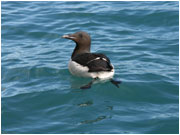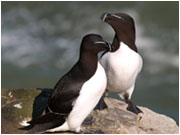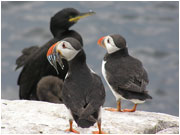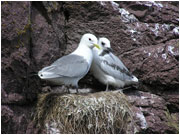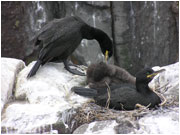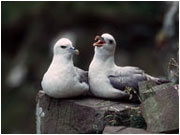In the summer months the sea cliffs at St Abb’s Head become home to tens of thousands of seabirds, squawking and jostling for space on the rock faces. Many like guillemots, razorbills and kittiwakes spend most of their lives on the open sea sometimes many miles from land, but in the spring they must come ashore to lay their eggs. St Abb’s Head is an ideal nesting site because the ledges, cracks and crevices of the cliffs are out of reach of land predators that might eat eggs or small chicks. The best place to watch the hustle and bustle of a seabird colony is north of the lighthouse at St Abb’s Head, but seabirds can be watched from anywhere along the coast path which runs the length of the Marine Reserve.
Guillemots
Guillemots are penguin-like birds with white fronts, brownish-black backs and dagger bills. They crowd tightly together on the broader ledges where they gain safety in numbers. They do not build a nest but just lay the egg directly on the rock. The egg is pear-shaped so that it will roll round in a circle if kicked rather than dropping off the cliff edge. Nest sites must have a clear drop to the sea below because the young leave the ledges before they can fly.
Razorbills
Razorbills look similar at first sight but can be distinguished by their jet-black backs and shorter, thicker bills that have narrow white markings. They prefer to nest singly or in small groups beside cracks and crevices or on narrow ledges. They also have pear-shaped eggs and nest only on cliffs that have a clear drop to the sea below.
Puffins
Puffins do breed at St Abbs but only in small numbers. They have the same overall black and white colouration as guillemots and razorbills but the white face patch and the bright orange feet are the best distinguishing features to look out for. Puffins nest in burrows where they lay one egg. The best time to spot them is in the morning or the evening. Guillemots, razorbills and puffins are present at St Abbs between April and July and then disperse widely in the North Sea for the rest of the year.
Kittiwakes
Kittiwakes are small graceful gulls with yellow bills, black legs and silver-grey wings with black tips. They are named after the distinctive calls they make. They build cup-like nests out of grass, mud and seaweed which they stick to the tiniest ledges on vertical cliff faces and in which they will lay 2 or 3 eggs. Kittiwakes can be seen at St Abbs between April and August.
Shags
Shags are large, black birds with long necks that use the low, flat rocks for nesting and roosting. They fish close inshore and fly low to the water often carrying pieces of seaweed in their bill for nest material. The name comes from the crest of feathers on the top of the head. They are present all year round.
Fulmar
Fulmars have long, narrow, dark grey wings and are white underneath. They are supreme gliders using air currents to soar along the cliff tops. They nest high up on grassy ledges or in round crevices defending themselves by spitting smelly fish oil at any intruders. They are present all year but can be scarce in mid winter.
